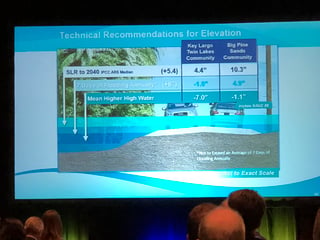 I wrapped up my 2017 travel at the 9th Annual Southeast Florida Regional Climate Leadership Summit. This event continues to grow and inspire with nearly 600 attendees this year! The Summit actually sold out this year and they worked with the Broward County Convention Center to adjust room layouts so they could accommodate extra people, allowing an additional 40 people to attend.
I wrapped up my 2017 travel at the 9th Annual Southeast Florida Regional Climate Leadership Summit. This event continues to grow and inspire with nearly 600 attendees this year! The Summit actually sold out this year and they worked with the Broward County Convention Center to adjust room layouts so they could accommodate extra people, allowing an additional 40 people to attend.
If you attended the Summit and are ready to take the next steps in your community, check out our Climate Leadership package and online Dashboard for community engagement.
For those that are unfamiliar, the four southeastern counties in Florida- Palm Beach, Broward, Miami-Dade, and Monroe- and their associated municipalities have been working together to address climate change since 2009, when they created the Southeast Florida Regional Climate Change Compact.
 The Compact calls for the Counties to work cooperatively to (Source):
The Compact calls for the Counties to work cooperatively to (Source):
- Develop annual Legislative Programs and jointly advocate for state and federal policies and funding
- Dedicate staff time and resources to create a Southeast Florida Regional Climate Action Plan to include mitigation and adaptation strategies
- Meet annually in Regional Climate Summits to mark progress and identify emerging issues.
This group has been a leader on addressing climate change at the local level. Notable accomplishments include (Source):
- Driving the state legislature to create Adaptation Action Area (AAA) designations for areas uniquely vulnerable to climate impacts, including sea level rise, to serve as a planning tool and encourage technical assistance.
- Development of the Southeast Florida Regional Climate Action Plan (RCAP) and implementation of the Plans 110 action items aimed at both reducing greenhouse gas emissions and adapting to the effects of climate change.
- Creation of a Unified Sea Level Rise Projection that is to be used by the “Climate Compact Counties and partners for planning purposes to aid in understanding of potential vulnerabilities and to provide a basis for developing risk informed adaptation strategies for the region.”
 This Summit, like the ones before it, brought together leaders from the national, state, and local levels to inspire action, share experiences, and promote leadership and innovation.
This Summit, like the ones before it, brought together leaders from the national, state, and local levels to inspire action, share experiences, and promote leadership and innovation.
Congressman Ted Deutch represents parts of Broward and Palm Beach counties and founded the Climate Solutions Caucus to engage a diverse group in Congress on a conversation around climate change.
He addressed the Summit and noted that certain climate models show 36 US cities will be completely destroyed and 1 in 8 florida homes will be underwater. From upgrading building codes to requiring higher seawalls, Deutch implored Florida local governments to be the spark that triggers climate discussions and action in D.C.
Rising seas and temperatures were on everyone’s mind, and solutions that were on the table at the Summit ranged from cool roofs and streets to growing tree canopy (a topic we covered in a recent podcast). I loved hearing from some of the following speakers about various impacts, approaches and solutions:
- Rhonda Haag (Monroe County) on Key Largo King Tide Flooding in October 2015
 for three weeks straight. She also noted that no roads in Monroe County (home to 75,000) have been elevated yet, and they don’t have the money to raise all the streets at once; but Key Largo needs a 5 inch elevation and Big Pine needs to go up by 11 inches. They are planning to take a phased approach to address these needs.
for three weeks straight. She also noted that no roads in Monroe County (home to 75,000) have been elevated yet, and they don’t have the money to raise all the streets at once; but Key Largo needs a 5 inch elevation and Big Pine needs to go up by 11 inches. They are planning to take a phased approach to address these needs.
- Jennifer Jurado (Broward County) on their PACE efforts focusing on existing
 building stock and the future conditions map that has turned into law through a code of ordinances that were adopted earlier this year. The County Board moved forward with a new map on flood elevations and it is that map that will now be applied to new development and major redevelopment projects. This is particularly important because Broward County is already built out. They are now prepared to update the 100-year community flood map, not used insurance purposes, but to establish appropriate elevation for buildings. The County is also working with 9 municipalities and drainage districts that will cost share to provide additional discounts on flood insurance policies through the Community Rating system.
building stock and the future conditions map that has turned into law through a code of ordinances that were adopted earlier this year. The County Board moved forward with a new map on flood elevations and it is that map that will now be applied to new development and major redevelopment projects. This is particularly important because Broward County is already built out. They are now prepared to update the 100-year community flood map, not used insurance purposes, but to establish appropriate elevation for buildings. The County is also working with 9 municipalities and drainage districts that will cost share to provide additional discounts on flood insurance policies through the Community Rating system.
- Nichole Hefty (Miami-Dade County) talked quite a bit about the 100 Resilient
 Cities program that it has been engaged with over the last year as a regional partnership between the County and the cities of Miami and Miami Beach. They have just released the draft of their Resilient Greater Miami & the Beaches preliminary resilience assessment report, which looks at four shocks and four stressors.
Cities program that it has been engaged with over the last year as a regional partnership between the County and the cities of Miami and Miami Beach. They have just released the draft of their Resilient Greater Miami & the Beaches preliminary resilience assessment report, which looks at four shocks and four stressors.
- Delaney Reyonds. Refreshing to have the youth voice represented at the Summit given the high stakes for generations not yet represented in Congress. As the founder of The Sink or Swim Project, she talked about moving from raising awareness to taking action and encouraged folks to talk to their local governments about incorporating sea level rise into their budget, which she did successfully with Miami-Dade County.
I also learned from Roderick Scott of L&R Resources, LLC, that there are three million homes in the US and 600,000 in Florida that were built before flood mapping existed and that these buildings are in the flood zone. Historically, they have been given subsidies for their flood insurance. We are now seeing these subsidies consistently removed, making it nearly impossible to sell these homes. He goes on to say that there are basically three options for residential flood mitigation:
- Elevate
- Relocate
- Demolition
Not great options if you have spent your whole life in one of these homes. I had this on my mind when I saw the Inman headline “Coastal Mortgage Time Bomb”: “A growing number of experts fear that sea level rise and flooding will devastate coastal real estate values, which in turn could cause the U.S. housing market to suffer a crash worse than 2007-2008 financial crisis.”
The bottom line is that much of Florida could be decimated if climate change continues unchecked and if cities and counties don’t take adequate steps to prepare. But I didn’t leave the Summit in Florida disheartened as the energy from the 600 of us gathered there was a strong indicator of what is possible. I talked to countless local  government representatives who are determined to fill the leadership vacuum on climate issues at the state and federal levels.
government representatives who are determined to fill the leadership vacuum on climate issues at the state and federal levels.
If you’re one of them, I encourage you to think about what legacy you’ll leave behind for your constituents -- not to mention your children and grandchildren -- and what tools you need to lead your community with climate solutions and make your community a leader.
You can learn more about our Climate Leadership package, one of many ways that KLA can partner with you to accomplish your climate goals hand-in-hand with your community members.



